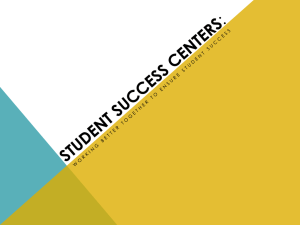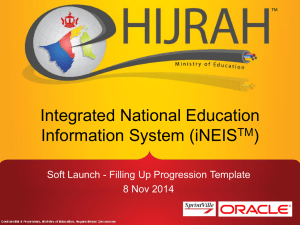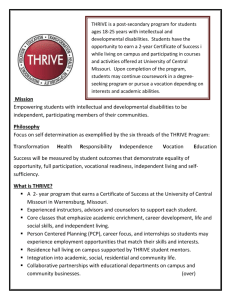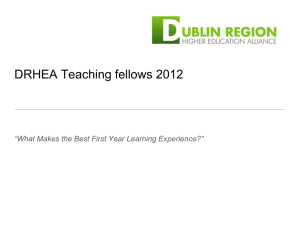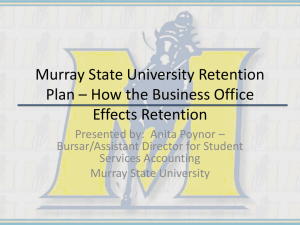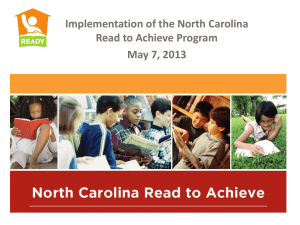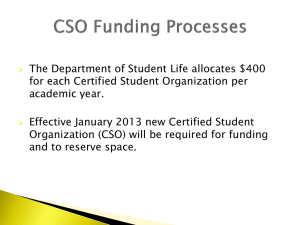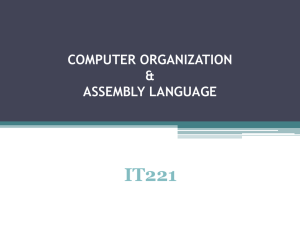Why the First Year Matters - Admissions
advertisement
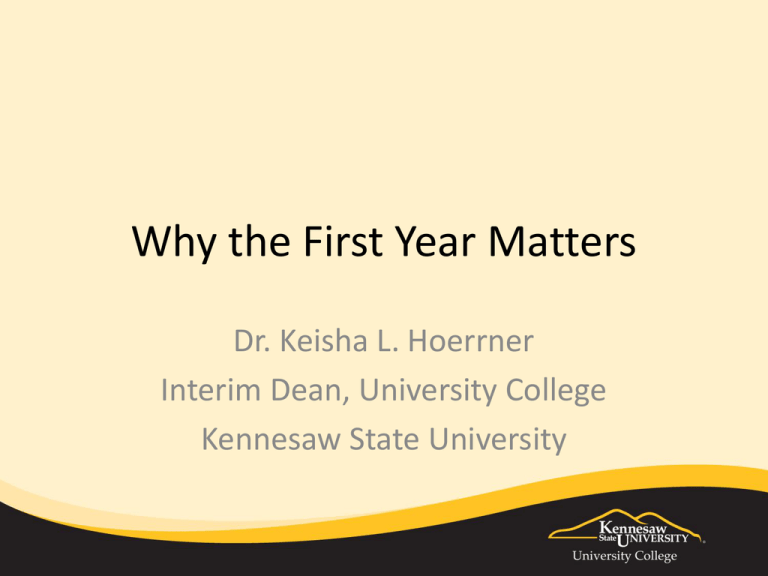
Why the First Year Matters Dr. Keisha L. Hoerrner Interim Dean, University College Kennesaw State University The Evolution • “Sink or Swim” was replaced by R-P-G Retention Progression Graduation First-Year Retention • First-to-second-year retention generally most critical component to many RPG initiatives • Variety of issues impact retention rates including selectivity, admissions standards, student characteristics, institutional characteristics, and more • Focus for students and parents should be on intentionality by institution to increase RPG Tinto: Taking Retention Seriously • “Students are more likely to persist and graduate in settings that hold high and clear expectations….” – Challenging but explicit classroom expectations – Academic advising that provides the roadmap to degree completion – Quite the opposite of the sense that making the courses easier will lead to success Tinto: Taking Retention Seriously • Provide academic and social support – Students may not be prepared for the rigors of university coursework so institutions should provide an array of support structures – Students need “safe havens” as they learn to navigate campuses • Counseling • Mentoring • Connections to peers Tinto: Taking Retention Seriously • “Feedback is a condition for student success” – Early alert/intervention programs – Assessments to accurately gauge student learning [not just exams] – Faculty willingness to adjust based on feedback – Timely feedback about performance – Connecting support structures to feedback Tinto: Taking Retention Seriously • “Involvement is a condition for student retention” – Academic and social integration opportunities with faculty, peers, and staff members • “The more students learn, the more they find value in their learning, the more they persist and graduate” – Build educational communities of learning College Board Pilot Study on Student Retention • Comprehensive national survey that looked not only at retention, progression and graduation rates (public v. private, etc) but also provided benchmarks for institutions – – – – – – Program coordination Research and assessment Orientation programs Early warning systems Faculty/student interactions Advising practices High-Impact Practices • Grounded in research • Increase rates of student retention and student engagement • Named HIPs by AAC&U • Should be integrated, available to all students, and continually assessed The HIPs • First-year seminars and experiences • Common intellectual experiences • Learning communities • Writing-intensive courses • Collaborative assignments and projects • Undergraduate research • Diversity/global learning • Service learning/ community-based learning • Internships • Capstone courses and projects KSU’s First-Year Focus • First-year seminars – 30-year history – KC 101 to four distinct seminars • • • • KSU 1101 KSU 1111 KSU 1121 KSU 1200 • Learning communities – Theme-based cohort of first-semester courses • Common reader • First-Year Convocation • President’s Annual 4.0 Luncheon • First-Year Residential Experience (FYRE) • Mandatory orientation and advising Thrive • • • • Idea grew out of the KSU graduation study Developed collaboratively by CSL and FYTS Focus is on HOPE-eligible FTFT students 1st pilot: ~200 students – Recruited in spring 2011 – Now juniors • Results: Very successful Components of Thrive • Graduation Coach • April registration and advising – Must take MAPT – Working with advisers to design schedules • June academic success workshops – Connecting to campus – Focus on foundational success skills • July Advance – Follows a special New Student Orientation session – Team building, listening skills, community service projects • Summer assignment: Student Leadership Challenge Components of Thrive • Fall Semester – KSU 1200 sections • All will be in LCs in 2014 – Resource room in UV – Monthly social events – Graduation Coach meetings (required) – Connections to academic advisers – Housing option • Spring Semester – Leadership development opportunities (CSL) – Community service projects – Resource room – Quarterly social events – Graduation Coach meetings (optional) – Housing option Retention Results • Thrive participants – when compared to academically and demographically matched control groups – earn better grades – progress more rapidly in academic standing – are retained at higher levels – are more likely to retain HOPE eligibility Thrive Results • Performance of Thrive Participants vs. Control Group – retained to 2nd Year Metric Cohort 1 (Class of 2015) Cohort 2 (Class of 2016) Control (n=170) Thrive (n=172) Control (n=186) Thrive (n=183) Students retained (n) 134 146 125 154 Students retained (%) 79 85 67 84 Retained students with a GPA >3.0 (%)a 52 72 60 66 Retained students with credit hours >30 by start of 2nd fall (%) 59 71 54 69 a Based on the GPA at the end of spring semester (checkpoint for maintenance of HOPE support) Thrive Results • Performance of Thrive Participants vs. Control Group – retained to 3rd Year a Metric Control (n=170) Thrive (n=172) Students retained (n) 108 122 Students retained (%) 64 71 Retained students with a GPA >3.0 (%)a 50 67 Retained students with credit hours >60 hours by start of 3nd fall (%) 40 60 Based on the GPA at the end of spring semester (checkpoint for maintenance of HOPE support) Unanticipated Positive Results • Performance of Minority Thrive Participants vs. Control Group – retained to 2nd Year Metric Cohort 1 Cohort 2 Control (n=38) Thrive (n=34) Control (n=39) Thrive (n=39) Students retained (n) 30 32 27 34 Students retained (%) 79 94 69 87 Retained students with a GPA >3.0 (%)a 31 78 44 74 Retained students with credit hours >30 by start of 2nd fall (%) 51 84 48 71 a Based on the GPA at the end of spring semester (checkpoint for maintenance of HOPE support) Supplemental Instruction • National model launched at KSU in 2006 • Optional facilitated weekly sessions • Targets 1000- and 2000-level courses with historically high D,F, W rates • Faculty member selects peer facilitator • Very successful results Current Status of SI • Spring ‘06: 2 sections • Fall ‘13: 57 sections • Fall 2013 Data – 20 courses served by 31 facilitators – 1581 students participated at least once – 7485 total contact hours SI Results • Data gathered on students who participate vs. those who do not within the same sections • Qualitative data collected each semester as part of program assessment – Faculty – Facilitators – Student attendees SI Results • Fall 2013: – Mean SI Grade: 2.53 vs. Mean Non-SI Grade: 2.18 DFW Rate Comparisons 60% Percent 50% 40% 30% 26.7% 21% 20% 22% 16% 10% 8% 20.5% 17.9% 14.5% 16% 17.4% 21% 19.3%19.2% 21% 24% 23% SI DFW Non SI DFW 0% S'06 F'06 S'07 F'07 S'08 F'08 S'09 F'09 S'10 F'10 S'11 F'11 S'12 F'12 S'13 F'13 Semester U.S. News and World Report “America’s Best Colleges” 2014 • Ranks 16 institutions for exemplary First-Year Experiences – – – – – – Alverno College (WI) Appalachian State (NC) Ball State U (IN) Bowling Green State (OH) Elon University (NC) Evergreen State College (WA) – Indiana U – Bloomington – – – – – – – – – IUPUI Kennesaw State U (GA) Ohio State University Stanford University U of Maryland – College Park U of North Carolina – Chapel Hill U of South Carolina Wagner College (NY) Washington U in St. Louis Questions and Contact Information • Dr. Keisha L. Hoerrner – Interim Dean, University College – uc@kennesaw.edu – 770-499-3550 – www.kennesaw.edu/uc
